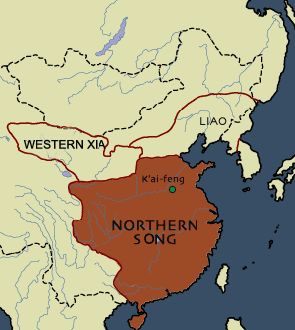
|
10. Northern Song Dynasty Map - (AD 960 to 1279 - 320 Years)
In 960 AD, a new power, the Song (960 to 1279 AD), reunited most of China proper. The Song period divides into two phases, Northern Song (960 to 1127), and Southern Song (1127 to 1279). The division was caused by the forced abandonment of north China in 1127 by the Song court, which could not push back the nomadic invaders. The founders of the Song Dynasty built an effective centralized bureaucracy staffed with civilian scholar-officials. This system of civilian rule led to a greater concentration of power in the emperor and his palace bureaucracy than had been achieved in the previous dynasties. The Song Dynasty is notable for the development of cities, not only for the administrative purposes, but also as centers of trade, industry, and maritime commerce. A new group of wealthy commoners -- the mercantile class -- arose as printing and education spread, private trade grew, and a market economy began to link the coastal provinces and the interior. Landholding and government employment were no longer the only means of gaining wealth and prestige. Zhu Xi's philosophy became official imperial ideology and evolved into a rigid official obligation of obedience and compliance of subject to ruler, child to parent, wife to husband, and younger brother to elder brother. The effect was to inhibit the societal development of premodern China, resulting both in many generations of political, social, and spiritual stability and in a slowness of cultural and institutional change up to the nineteenth century. Kublai Klan defeated the Southern Song to begin the Yuan Dynasty in 1279 AD. Return to Chinese Dynasty Map Choices - Page 2 ⇦ Back to 9. Five Dynasties Dynasty On to 11. Southern Song Dynasty ⇨ |